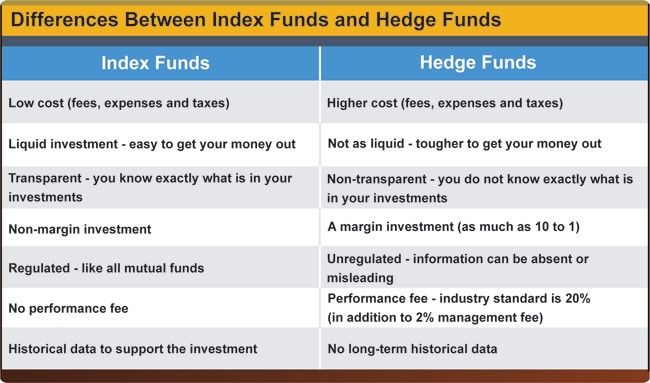Differences between Index Funds
Post on: 30 Июль, 2015 No Comment

From costs to benchmarks, there’s a lot that drives the performance of an index fund. Started in a garage (okay, not really) by John Bogle back in ’76, index funds now make up 27% of all open-end mutual and ETF assets in the U.S. – a figure that is only growing – according to Morningstar. And, they are not all built the same.
As a type of mutual fund, an index fund is a basket of securities. However, unlike other mutual funds the securities in an index fund are not actively added or removed by a manager. Instead, index funds are designed to match both the performance and structure of an index, such as the S&P 500.
Yet, even funds that follow the same index are not identical. They can differ in cost, structure and performance. In the end, the differences are generally insubstantial; they are good investments any way you look at it. Nonetheless, by comparing index fund features, an investor can see what revs them up so that they keep pace with the market.
Costs
With any investment, the most important consideration is cost. After all, expenses always decrease returns. One of the benefits of index funds is their low cost. On average, they cost far less than actively managed funds since they do not carry all the expenses from sales commissions, frequent trading and various management fees.
However, the proliferation of index funds has led to increased competition and variations in pricing. For example, the Vanguard 500 Index Fund charges 0.05% annually while some similar S&P 500-tracking funds charge around 1% or more. That is a difference of $5 per $10,000 invested compared to $100 per $10,000 invested.
It is never acceptable to pay high costs for an index fund, especially when cheaper and just-as-effective alternatives are available. A rule of thumb: Don’t pay active fund prices for index funds.
Benchmarks
An index fund’s benchmark is the index that it attempts to replicate. Benchmarks can range from traditional indexes such as Dow Jones, Wilshire and NASDAQ; to broader indexes that capture the entire stock or bond markets; to indexes tied to specific geographic regions; to single industry sectors; and even unconventional categories such as socially responsible companies.
Investors can choose any asset class they want in their portfolio and likely can find an index for it as well as a fund that tracks it. A total market index fund is a great starting point, as the average investor has no need for more exotic, riskier indexes.
The securities inside
Index funds are model investment vehicles when it comes to transparency. Investors know exactly what they are buying because they have full access to what’s inside the benchmark, which determines the securities held in the fund. Ideally, an index fund holds the same securities at the same weights, or market shares, as its benchmark. How securities from different indexes compare are generally based on characteristics such as size and style for stocks and maturity and quality for bonds.
Stock index size and style
Stocks in an index are differentiated by the size (large, mid and small) of the company and the style (value or growth), which is the company’s valuation. Value stocks have low prices and are companies with lower earnings and uncertain prospects. Conversely, growth stocks have high prices and are companies with positive outlooks and recent profits.
Based on its benchmark, an index fund can hold specific stock sizes and styles or a blend of each. For example, the Vanguard U.S. Total Stock Market Index Fund (VTSMX) primarily holds large-cap stocks as well as mid and small caps, all blended across growth and value styles. What category a stock falls under is at the discretion of the index provider, which differs from one to the other.
Bond index maturity and quality
Meanwhile, bonds are commonly divided by maturity (short term, intermediate and long term) and quality (high yield, investment grade and U.S. government). Maturity is the amount of time before the bond returns the principal, or purchase price, to the buyer. Quality is a measure of the bond’s creditworthiness, with the U.S. government as the safest investment because of the low chance of a default. Like stocks, bond index funds may either hold specific types or a blend.
Tracking error
Since index funds do not attempt to beat a benchmark, their performance is measured by how closely they mirror it. The amount by which an index fund and its benchmark differ in performance is called tracking error. It is a good indication as to how well an index fund is structured. An index fund that perfectly matches its benchmark has a tracking error of zero. However, because of costs it is a near impossibility for any index fund to do so.
Objects in funds may be more active than they appear
Some funds are marketed as index funds but are actually actively managed funds. Typically, they track an index that follows an active strategy. Such funds can still use the title “index” since they follow the basic fundamentals of an index. However, shareholders will not receive the same benefits of a broad, diversified index fund.
Choosing the right index fund is dependent on the investor’s financial goals. Does the fund represent the asset class desired and at the lowest cost? Ultimately, the most important decision is to choose low-cost index funds and leave expensive actively managed funds in the dust.














